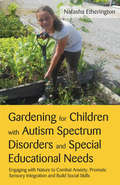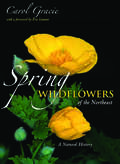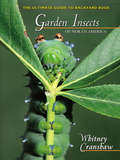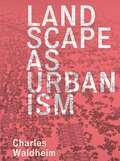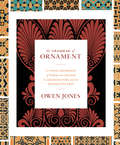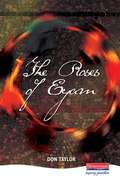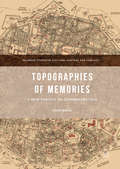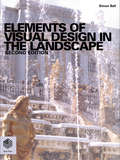- Table View
- List View
Seedling and light (large print)
by RnibThis page shows an image of a bright light bulb and a small seedling. There is a locator dot shown, which will be at the top left, when the image is the correct way up. The light bulb is on the left of the page. It is in a small vertical stand. The seedling is on the right of the page. It is growing in a small pot and has two leaves. It is bending towards the light as it responds to it. edling. There is a locator dot shown, which will be at the top left, when the image is the correct way up.
Seedling and light (UEB contracted)
by RnibThis page shows an image of a bright light bulb and a small seedling. There is a locator dot shown, which will be at the top left, when the image is the correct way up. The light bulb is on the left of the page. It is in a small vertical stand. The seedling is on the right of the page. It is growing in a small pot and has two leaves. It is bending towards the light as it responds to it.
Seedling and light (UEB uncontracted)
by RnibThis page shows an image of a bright light bulb and a small seedling. There is a locator dot shown, which will be at the top left, when the image is the correct way up. The light bulb is on the left of the page. It is in a small vertical stand. The seedling is on the right of the page. It is growing in a small pot and has two leaves. It is bending towards the light as it responds to it.
Water loss in plants (large print)
by RnibThis page shows an image of a small plant growing in the ground. There is a locator dot shown, which will be at the top left, when the image is the correct way up. The image is surrounded by a dashed line image border. The green leafy part of the plant is in the top half of the page and the root is in the bottom half of the page. The plans stem goes vertically up the middle of the page. It has three oval leaves on the left, one at the top forming the shoot, and four leaves on the right. Curved arrows indicate water loss as vapour from the leaves. A line going horizontally across the middle of the page represents the soil surface. Down from this the soil is shown in cross section so the roots can be found. As the root goes down the page it divides into smaller multiples of roots. Arrows show the root absorbing water from the soil.
Umbrella Tree showing it's Aerial roots (UEB contracted)
by RnibOn this page there is an image of a branch of an Umbrella Tree (Schefflera arbicola) with three aerial roots growing down to the soil. There is a locator dot shown, which will be at the top left of the page when the image is the correct way up. There are two groups of leaves at the top of the page, each with seven green, pointed oval leaves in a circular umbrella arrangement. These are attached to the plans pale brown branch by delicate stems leading down the page. Follow the branch to the right and you will find three aerial roots. Two of them fork into two before going down to the red earth at the bottom of the page. Many other plants have aerial roots including Ivy, many orchids, mangroves trees and the fantastical Banyan tree.
Umbrella Tree showing it's Aerial roots (large print)
by RnibOn this page there is an image of a branch of an Umbrella Tree (Schefflera arbicola) with three aerial roots growing down to the soil. There is a locator dot shown, which will be at the top left of the page when the image is the correct way up. There are two groups of leaves at the top of the page, each with seven green, pointed oval leaves in a circular umbrella arrangement. These are attached to the plans pale brown branch by delicate stems leading down the page. Follow the branch to the right and you will find three aerial roots. Two of them fork into two before going down to the red earth at the bottom of the page. Many other plants have aerial roots including Ivy, many orchids, mangroves trees and the fantastical Banyan tree.
Umbrella Tree showing it's Aerial roots (UEB uncontracted)
by RnibOn this page there is an image of a branch of an Umbrella Tree (Schefflera arbicola) with three aerial roots growing down to the soil. There is a locator dot shown, which will be at the top left of the page when the image is the correct way up. There are two groups of leaves at the top of the page, each with seven green, pointed oval leaves in a circular umbrella arrangement. These are attached to the plans pale brown branch by delicate stems leading down the page. Follow the branch to the right and you will find three aerial roots. Two of them fork into two before going down to the red earth at the bottom of the page. Many other plants have aerial roots including Ivy, many orchids, mangroves trees and the fantastical Banyan tree.
Water loss in plants (UEB uncontracted)
by RnibThis page shows an image of a small plant growing in the ground. There is a locator dot shown, which will be at the top left, when the image is the correct way up. The image is surrounded by a dashed line image border. The green leafy part of the plant is in the top half of the page and the root is in the bottom half of the page. The plans stem goes vertically up the middle of the page. It has three oval leaves on the left, one at the top forming the shoot, and four leaves on the right. Curved arrows indicate water loss as vapour from the leaves. A line going horizontally across the middle of the page represents the soil surface. Down from this the soil is shown in cross section so the roots can be found. As the root goes down the page it divides into smaller multiples of roots. Arrows show the root absorbing water from the soil.
Welwitschia (large print)
by RnibThis is an image, seen from the side, of a Welwitschia. It is a gymnosperm these are plants with cones, for example conifers. It is native only to the Nabib desert in Namibia and Angola and has no close relatives. There is a locator dot shown, which will be at the top left of the page when the image is the correct way up. The image has a dashed line image border.There is a cross section through desert soil stretching across the bottom quarter of the page.The plans roots branch out left and right through the soil from its very short woody stem in the bottom right of the page.Above this the image of the plant stretches across the bottom part of the page.It only has two twisted strap-like leaves throughout its life. They extend to the left and right from its stem. The leaf to the right extends beyond the image border. The leaves have two different textures (colours in Large Print). A lined texture (light green/brown) represents the top surface of the leaves and a fine dotted texture (dark green) the underside of the leaves. The twisted form of the leaves means that sections of both their top surfaces and the undersides can be found. These leave continue to grow throughout the plans life, becoming brown and frayed at their ends, and forming a tangled mass covering several square metres.The plant absorbs most of the water it needs through its leaves from the mists rolling in from the sea.The Welwitschia can live for more than 2000 years
Welwitschia (UEB contracted)
by RnibThis is an image, seen from the side, of a Welwitschia. It is a gymnosperm these are plants with cones, for example conifers. It is native only to the Nabib desert in Namibia and Angola and has no close relatives. There is a locator dot shown, which will be at the top left of the page when the image is the correct way up. The image has a dashed line image border.There is a cross section through desert soil stretching across the bottom quarter of the page.The plans roots branch out left and right through the soil from its very short woody stem in the bottom right of the page.Above this the image of the plant stretches across the bottom part of the page.It only has two twisted strap-like leaves throughout its life. They extend to the left and right from its stem. The leaf to the right extends beyond the image border. The leaves have two different textures (colours in Large Print). A lined texture (light green/brown) represents the top surface of the leaves and a fine dotted texture (dark green) the underside of the leaves. The twisted form of the leaves means that sections of both their top surfaces and the undersides can be found. These leave continue to grow throughout the plans life, becoming brown and frayed at their ends, and forming a tangled mass covering several square metres.The plant absorbs most of the water it needs through its leaves from the mists rolling in from the sea.The Welwitschia can live for more than 2000 years
Home (PDF)
by Alison Blunt Robyn Dowling'Home' is a significant geographical and social concept. It is not only a three-dimensional structure, a shelter, but it is also a matrix of social relations and has wide symbolic and ideological meanings; home can be feelings of belonging or of alienation; feelings of home can be stretched across the world, connected to a nation or attached to a house; the spaces and imaginaries of home are central to the construction of people's identities. An essential guide to studying home and domesticity, this book locates 'home' within wider traditions of thought. It analyzes different sources, methods and examples in both historical and contemporary contexts; ranging from homes on the American frontier and imperial domesticity in British India, to Australian suburbs, multicultural London, and South Asian diasporic homes. The core argument of the book has three main parts that cut across each of its chapters: home-making identity and belonging homely and unhomely spaces. Each chapter includes text boxes and exercises and is well illustrated with cartoons, line drawings, and photographs. Outlining the social relations shaping, (and being influenced by) the geographies of home; and the imaginative as well as material importance of home, this book will be a valuable reference for students of geography, sociology, gender studies, and those interested in the home and domesticity.
Gardening for Children with Autism Spectrum Disorders and Special Educational Needs
by Natasha Etheringtonxx
Spring Wildflowers of the Northeast: A Natural History
by Carol Gracie Eric LamontThis exquisitely illustrated volume provides an in-depth look at spring-blooming wildflowers of the Northeast, from old favorites to lesser-known species. Featuring more than 500 full-color photos in a stunning large-sized format, the book delves deep into the life histories, lore, and cultural uses of more than 35 plant species. The rich narrative covers topics such as the naming of wildflowers; the reasons for taxonomic changes; pollination of flowers and dispersal of seeds; uses by Native Americans; related species in other parts of the world; herbivores, plant pathogens, and pests; medicinal uses; and wildflower references in history, literature, and art. The photos capture the beauty of these plants and also illustrate the concepts discussed in the text. A book unlike any other, Spring Wildflowers of the Northeast combines the latest scientific research with an accessible, entertaining style, making it the ideal volume for readers of all levels of expertise. Showcases the Northeast's most spectacular spring-blooming wildflowers Features more than 500 full-color photos Covers the life histories, lore, and cultural uses of more than 35 species Combines the latest scientific research with an easy-to-read style Offers something new for seasoned botanists as well as armchair naturalists
Garden Insects of North America: The Ultimate Guide to Backyard Bugs
by Whitney CranshawGarden Insects of North America is the most comprehensive and user-friendly guide to the common insects and mites affecting yard and garden plants in North America. In a manner no previous book has come close to achieving, through full-color photos and concise, clear, scientifically accurate text, it describes the vast majority of species associated with shade trees and shrubs, turfgrass, flowers and ornamental plants, vegetables, and fruits--1,420 of them, including crickets, katydids, fruit flies, mealybugs, moths, maggots, borers, aphids, ants, bees, and many, many more. For particularly abundant bugs adept at damaging garden plants, management tips are also included. Covering all of the continental United States and Canada, this is the definitive one-volume resource for amateur gardeners, insect lovers, and professional entomologists alike. To ease identification, the book is organized by plant area affected (e.g., foliage, flowers, stems) and within that, by taxa. Close to a third of the species are primarily leaf chewers, with about the same number of sap suckers. Multiple photos of various life stages and typical plant symptoms are included for key species. The text, on the facing page, provides basic information on host plants, characteristic damage caused to plants, distribution, life history, habits, and, where necessary, how to keep "pests" in check--in short, the essentials to better understanding, appreciating, and tolerating these creatures. Whether managing, studying, or simply observing insects, identification is the first step--and this book is the key. With it in hand, the marvelous microcosm right outside the house finally comes fully into view. Describes more than 1,400 species--twice as many as in any other field guide Full-color photos for most species--more than five times the number in most comparable guides Up-to-date pest management tips Organized by plant area affected and by taxa for easy identification Covers the continental United States and Canada Provides species level treatment of all insects and mites important to gardens Illustrates all life stages of key garden insects and commonly associated plant injuries Concise, clear, scientifically accurate text Comprehensive and user-friendly
Garden Insects of North America: The Ultimate Guide to Backyard Bugs
by Whitney CranshawGarden Insects of North America is the most comprehensive and user-friendly guide to the common insects and mites affecting yard and garden plants in North America. In a manner no previous book has come close to achieving, through full-color photos and concise, clear, scientifically accurate text, it describes the vast majority of species associated with shade trees and shrubs, turfgrass, flowers and ornamental plants, vegetables, and fruits--1,420 of them, including crickets, katydids, fruit flies, mealybugs, moths, maggots, borers, aphids, ants, bees, and many, many more. For particularly abundant bugs adept at damaging garden plants, management tips are also included. Covering all of the continental United States and Canada, this is the definitive one-volume resource for amateur gardeners, insect lovers, and professional entomologists alike. To ease identification, the book is organized by plant area affected (e.g., foliage, flowers, stems) and within that, by taxa. Close to a third of the species are primarily leaf chewers, with about the same number of sap suckers. Multiple photos of various life stages and typical plant symptoms are included for key species. The text, on the facing page, provides basic information on host plants, characteristic damage caused to plants, distribution, life history, habits, and, where necessary, how to keep "pests" in check--in short, the essentials to better understanding, appreciating, and tolerating these creatures. Whether managing, studying, or simply observing insects, identification is the first step--and this book is the key. With it in hand, the marvelous microcosm right outside the house finally comes fully into view. Describes more than 1,400 species--twice as many as in any other field guide Full-color photos for most species--more than five times the number in most comparable guides Up-to-date pest management tips Organized by plant area affected and by taxa for easy identification Covers the continental United States and Canada Provides species level treatment of all insects and mites important to gardens Illustrates all life stages of key garden insects and commonly associated plant injuries Concise, clear, scientifically accurate text Comprehensive and user-friendly
Landscape as Urbanism: A General Theory
by Charles WaldheimIt has become conventional to think of urbanism and landscape as opposing one another—or to think of landscape as merely providing temporary relief from urban life as shaped by buildings and infrastructure. But, driven in part by environmental concerns, landscape has recently emerged as a model and medium for the city, with some theorists arguing that landscape architects are the urbanists of our age. In Landscape as Urbanism, one of the field's pioneers presents a powerful case for rethinking the city through landscape.Charles Waldheim traces the roots of landscape as a form of urbanism from its origins in the Renaissance through the twentieth century. Growing out of progressive architectural culture and populist environmentalism, the concept was further informed by the nineteenth-century invention of landscape architecture as a "new art" charged with reconciling the design of the industrial city with its ecological and social conditions. In the late twentieth and early twenty-first centuries, as urban planning shifted from design to social science, and as urban design committed to neotraditional models of town planning, landscape urbanism emerged to fill a void at the heart of the contemporary urban project.Generously illustrated, Landscape as Urbanism examines works from around the world by designers ranging from Ludwig Hilberseimer, Andrea Branzi, and Frank Lloyd Wright to James Corner, Adriaan Geuze, and Michael Van Valkenburgh. The result is the definitive account of an emerging field that is likely to influence the design of cities for decades to come.
The Grammar of Ornament: A Visual Reference of Form and Colour in Architecture and the Decorative Arts
by Owen JonesThe complete and unabridged full-color editionFirst published in 1856, The Grammar of Ornament remains a design classic. Its inspiration came from pioneering British architect and designer Owen Jones (1809–1874), who produced a comprehensive design treatise for the machine age, lavishly illustrated in vivid chromolithographic color. Jones made detailed observations of decorative arts on his travels in Europe, the Middle East, and in his native London, where he studied objects on display at the Great Exhibition of the Works of Industry of All Nations in 1851 and at local museums. His aim was to improve the quality of Western design by changing the habits of Victorian designers, who indiscriminately mixed elements from a wide variety of sources.Jones's resulting study is a comprehensive analysis of styles of ornamental design, presenting key examples ranging from Maori tattoos, Egyptian columns, and Greek borders to Byzantine mosaic, Indian embroidery, and Elizabethan carvings. At once splendidly Victorian and insistently modern, The Grammar of Ornament celebrates objects of beauty from across time periods and continents, and remains an indispensable sourcebook today.
The Grammar of Ornament: A Visual Reference of Form and Colour in Architecture and the Decorative Arts
by Owen JonesThe complete and unabridged full-color editionFirst published in 1856, The Grammar of Ornament remains a design classic. Its inspiration came from pioneering British architect and designer Owen Jones (1809–1874), who produced a comprehensive design treatise for the machine age, lavishly illustrated in vivid chromolithographic color. Jones made detailed observations of decorative arts on his travels in Europe, the Middle East, and in his native London, where he studied objects on display at the Great Exhibition of the Works of Industry of All Nations in 1851 and at local museums. His aim was to improve the quality of Western design by changing the habits of Victorian designers, who indiscriminately mixed elements from a wide variety of sources.Jones's resulting study is a comprehensive analysis of styles of ornamental design, presenting key examples ranging from Maori tattoos, Egyptian columns, and Greek borders to Byzantine mosaic, Indian embroidery, and Elizabethan carvings. At once splendidly Victorian and insistently modern, The Grammar of Ornament celebrates objects of beauty from across time periods and continents, and remains an indispensable sourcebook today.
The Pleasure Gardens of Virginia: From Jamestown to Jefferson
by Peter MartinUsing a rich assortment of illustrations and biographical sketches, Peter Martin relates the experiences of colonial gardeners who shaped the natural beauty of Virginia's wilderness into varied displays of elegance. He shows that ornamental gardening was a scientific, aesthetic, and cultural enterprise that thoroughly engaged some of the leading figures of the period, including the British governors at Williamsburg and the great plantation owners George Washington, Thomas Jefferson, William Byrd, and John Custis. In presenting accounts of their gardening efforts, Martin reveals the intricacies of colonial garden design, plant searches, experimentation, and the problems in adapting European landscaping ideas to local climate. These writings also bring to life the social and commercial interaction between Williamsburg and the plantations, together with early American ideas about cultured living. While placing Virginia's gardening in the larger context of the colonial South, Martin tells a very human story of how this art both influenced and reflected the quality of colonial life. As Virginia grew economically and culturally, the garden became a projection of the gardener's personal identity, as exemplified by the endeavors of Washington and Jefferson at Mount Vernon and Monticello. In order to recapture the gardens as they existed in colonial times, Martin brings together paintings, drawings, and the findings of modern archaeological excavations.Originally published in 1991.The Princeton Legacy Library uses the latest print-on-demand technology to again make available previously out-of-print books from the distinguished backlist of Princeton University Press. These editions preserve the original texts of these important books while presenting them in durable paperback and hardcover editions. The goal of the Princeton Legacy Library is to vastly increase access to the rich scholarly heritage found in the thousands of books published by Princeton University Press since its founding in 1905.
Roses Of Eyam (PDF)
by Butterworth-Heinemann Staff Don TaylorThis series of plays for the 11-16 age range offers contemporary drama and new editions of classic plays. The series has been developed to support classroom teaching and to meet the requirements of the National Curriculum Key Stages 3 and 4.
Topographies of Memories: A New Poetics of Commemoration
by Anita BakshiThis book explores new approaches towards developing memorial and heritage sites, moving beyond the critique of existing practices that have been the traditional focus of studies of commemoration. Offering understandings of the effects of conflict on memories of place, as manifested in everyday lives and official histories, it explores the formation of urban identities and constructed images of the city. Topographies of Memories suggests interdisciplinary approaches for creating commemorative sites with shared stakes. The first part of the book focuses on memory dynamics, the second on Nicosia, the divided capital of Cyprus, and the third on physical and material world interventions. Design practices and modes of engagement with places of memory are explored, making connections between theoretical explorations of memory and forgetting and practical strategies for designers and practitioners.
Topographies of Memories: A New Poetics of Commemoration
by Anita BakshiThis book explores new approaches towards developing memorial and heritage sites, moving beyond the critique of existing practices that have been the traditional focus of studies of commemoration. Offering understandings of the effects of conflict on memories of place, as manifested in everyday lives and official histories, it explores the formation of urban identities and constructed images of the city. Topographies of Memories suggests interdisciplinary approaches for creating commemorative sites with shared stakes. The first part of the book focuses on memory dynamics, the second on Nicosia, the divided capital of Cyprus, and the third on physical and material world interventions. Design practices and modes of engagement with places of memory are explored, making connections between theoretical explorations of memory and forgetting and practical strategies for designers and practitioners.
On Span and Space: Exploring Structures in Architecture
by Bjorn N. SandakerIn this richly illustrated book with many practical examples, Bjorn Sandaker provides readers with a better understanding of the relationship between technology and architecture. As an experienced teacher and writer, Sandaker offers a well-founded aesthetic theory to support the understanding and evaluation of a structure's form and design, examining concepts and viewpoints from both the professions of engineering and architecture. Comprehensively covering structure and aesthetics, this book is ideal for students, professionals and academics in the areas of architecture and building.
On Span and Space: Exploring Structures in Architecture
by Bjorn N. SandakerIn this richly illustrated book with many practical examples, Bjorn Sandaker provides readers with a better understanding of the relationship between technology and architecture. As an experienced teacher and writer, Sandaker offers a well-founded aesthetic theory to support the understanding and evaluation of a structure's form and design, examining concepts and viewpoints from both the professions of engineering and architecture. Comprehensively covering structure and aesthetics, this book is ideal for students, professionals and academics in the areas of architecture and building.
Elements of Visual Design in the Landscape
by Simon BellPublic concern about the landscape, in particular its appearance, is increasing all the time. For those charged with managing, developing or conserving a wide range of landscapes it is a major task to take visual aspects into account. Elements of Visual Design in the Landsacpe presents a vocabulary of visual design, structured in a logical and easy to follow sequence. It is profusely illustrated using both abstract and real examples taken from a wide range of international locations together with cross referencing between related principles and case studies demonstrating how the principles can be applied in practice. The visual aspects of design have often been treated as 'cosmetic' and therefore not meriting attention or purely subjective and therefore open to personal preference. Few attempts have been made to explain how we see the landscape in any rational and structured way, and to demonstrate how visually creative design and management can be undertaken. This book aims to fill that gap.


